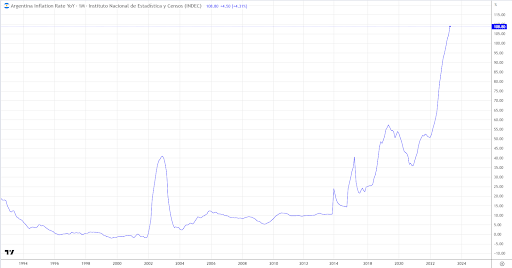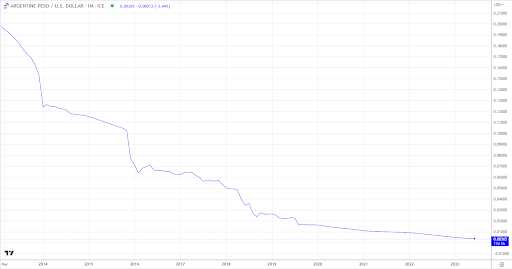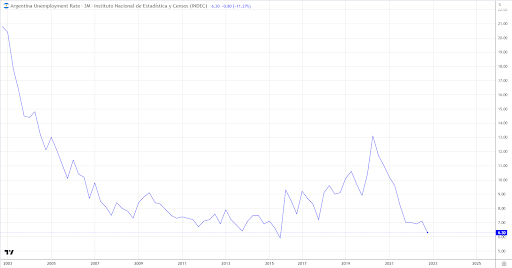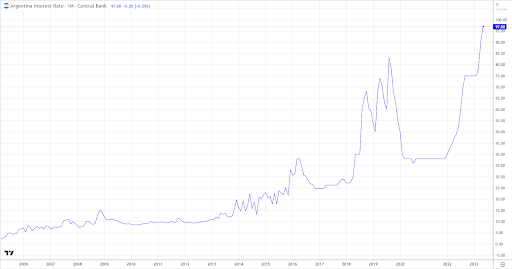
Argentina, once a highly developed economy in Latin America, has faced various challenges in recent years, including inflation, unemployment, and declining exports. However, the Government of Argentina has taken a number of measures to stabilize the economy.
One significant issue is the high inflation rate, which reached 47% in 2018, ranking among the highest in the world. This has led to a decrease in the purchasing power and a deterioration in the economic situation of the country. And as of April 1, 2023, inflation skyrocketed to 108%, which is the highest in recent decades.
Due to taxes and restrictions, a parallel foreign exchange market has emerged in Argentina, where one can find shadow currency exchangers operating outside the authorities’ oversight.
In 2019, there was a change in government leadership, with Alberto Fernandez assuming the presidency, a position he still holds. Inflation continued accelerating under his administration, amounting to 54% at the end of the year. The government faced difficulties in selling government bonds, and in May 2020 (when the pandemic was actively sending shock waves through the world economy), Argentina experienced another default, making it harder to obtain new financing.
In 2023 the prices more than doubled, pushing 40% of the population below the poverty line. The value of the national currency, the peso (ARS), is constantly falling, and the gap between the official and unofficial exchange rates reaches colossal proportions.
Those Argentines who have savings are trying to protect them from inflation by purchasing dollars, despite strict currency restrictions imposed by the government. According to the official exchange rate set by the authorities, individuals can buy no more than $200 per month. With additional taxes, the actual exchange rate differs significantly from the official one, sometimes reaching up to a 100% difference.

The rapid rise in the price of consumer goods forced the Central Bank to introduce a new 2000 peso note in late May. This inflation has made it difficult for consumers to gauge the normal price of products.
Another pressing issue in the Argentina’s economy is unemployment. In 2020, the unemployment rate reached 13%, a high figure for a country with significant economic development. In 2023, the unemployment rate decreased to 6.3%, a positive indicator considering the hyperinflation context.

To address unemployment, the Government of Argentina focuses on job creation and support for small and medium-sized business. Additionally, they have pursued the tax system reforms, reduced public spending, and aimed to improve infrastructure to stimulate economic growth.
In mid-May 2023, the Central Bank of Argentina raised the key rate by six percentage points, to 97%. In global practice, this rate is currently surpassed only by Zimbabwe. Such measures make lending essentially inaccessible and seriously affect the prospects of economic development, however in theory they aim to curb rising prices. Analysts fear that the moment for effective policy tightening may have been missed, raising doubts about the Central Bank’s ability to halt price increases.

Despite the Government’s diligent efforts, Argentina continues facing economic problems. In particular, the country faces competition from other countries in the global market, resulting in declining exports and a deteriorating trade balance. To boost exports, Argentina’s government is pursuing a policy of export development, including the creation of new enterprises and infrastructure improvements.
Recent reports indicate that Argentina may soon join the BRICS Development Bank, according to the economic data calendar.
The decision to establish the New Development Bank within the framework of BRICS was made in 2013 at the summit in Durban, South Africa. The commenced operations officially started on July 7, 2015. The primary objective of the institution is to finance infrastructure and sustainable development projects in BRICS member countries.
BRICS unites Brazil, Russia, India, China, and South Africa. Several other countries, including Argentina, Iran, and potentially Indonesia, Turkey, Saudi Arabia, and Egypt as per the Chinese Foreign Ministry, aim to join the economic bloc. South Africa assumed the BRICS presidency from China earlier this year, and it will hold the position until the end of 2023 before passing it on to the next country.
Such a decision could potentially have a positive impact on the struggling economy of Argentina and provide a fresh impetus through cooperation with the member countries. The global community will undoubtedly monitor these developments closely.

Leave a Reply